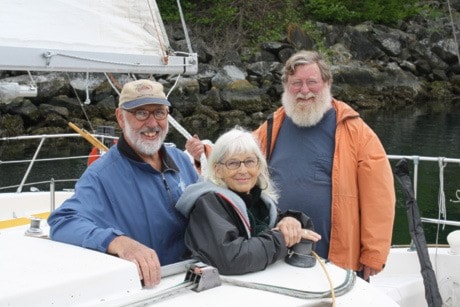To the non-sailor, the disparity in the size and shape among the gathered sailboats off Clover Point on Saturday morning can be a tad confusing.
They come for the Swifsure International Yacht Race. However, not all of the boats that finish the course first will finish in first place.
For the third straight year, Blair Humphrey and Diana Rowles are entering their sailboat, Red Beam, a 26-foot cruiser (7.9 metres), into the 17.8-nautical-miles-long Inshore Event.
Theirs is not a fast boat, which is why they race the Inshore course, formerly known as the Rosedale Rocks, which is the shortest of the Swiftsure events. The weekend’s longest is the Swiftsure Lightship Classic, 138.78 nautical miles.
“It’s quite clear for us winning is something we wouldn’t mind doing, but not something we expect,” Humphrey said.
The Classic is the hallmark event of the weekend and dates back to 1930, drawing sailboats and crews from B.C., Washington and Oregon. Also contested are the Cape Flattery (103.4 nautical miles) and Juan de Fuca (79.7 nautical miles) races.
Since 1981, Humphrey, Rowles and crew raced the Juan de Fuca in their previous boat, Main Squeeze. Once they even won their division.
Those days of competitive of weekly races and weekend regattas are now behind them. In 2009, Humphrey, a retired Camosun College chemistry instructor, and Rowles, a retired instructor of educational psychology at the University of Victoria, moved to their current boat, a more comfortable but slower sailing boat made by C&C Yachts.
“We were a lot more serious and (the J24) is much faster but we were getting quite wet in the open waters,” said Rowles.
But Humphrey and Rowles are not ready to let go of Swiftsure.
“Unfortunately, Red Beam wallows like a pig when sailing downwind,” Humphrey said, adding waves of the boat’s wake can catch up to them and soak the crew.
“Most racing boats aren’t designed to do that,” he laughed.
Red Beam was built in 1977 by Ontario-based C&C Yachts, known for constructing some relatively fast boats.
“Ours isn’t one of them. We’re a fairly slow boat with a cut-down jib, not quite as fast.”
In fact Red Beam’s race is so condition-dependent, added Humphrey, he and Rowles consider it “doing well” if they finish. In 2009 the conditions offered so little wind the Red Beam never made it to their half way mark.
Just don’t count them out.
Red Beam owns a 230 handicap rating, meaning because of its slow going, the boat is given 230 seconds to sail one nautical mile. It’s a rating that balances out quite well.
In total, Red Beam is allowed 4,094 seconds to sail their 17.9-nautical-mile course. Once they cross the finish line, their time will be adjusted by those 4,094 seconds, which works out to 68 minutes and 14 seconds.
At the other end of the spectrum, the fastest rated boat on the Inshore course is Surt, also from Victoria, with an 82 rating. To defeat Red Beam, Surt must complete the Inshore course nearly 44 minutes faster.
Ron Jewula, Swiftsure’s official handicapper, said the “sailors know just how much time they need to beat the next boat.
“Once we finish, we watch at the finish line and clock the times of the incoming boats.”
Did you know?
The slowest handicapped boat in the Swiftsure Lightship Classic is the navy’s HMCS Oriole at 165.
The fastest rated boat is Icon from Anacortes at -69. It will have 139 minutes added to its time in the Lightship Classic.
